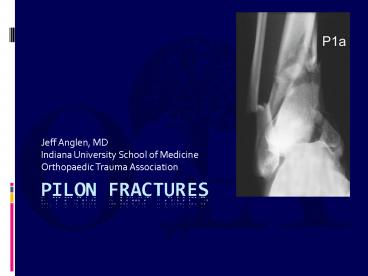PIlon Fractures PowerPoint PPT Presentation
1 / 58
Title: PIlon Fractures
1
PIlon Fractures
- Jeff Anglen, MD
- Indiana University School of Medicine
- Orthopaedic Trauma Association
2
WWW.OTA.ORG
3
(No Transcript)
4
Historical Perspective
- Prior to 1960s Not amenable to surgery
- Acceptable results in lt50
5
Ruedi and AlgöwerInjury 192-99, 1969
75 -90 Good and Excellent outcomes Results
durable for up to 10 years of follow-up
Four principles of operative treatment
- fix the fibula to restore length and alignment
- anatomically restore the articular surface
- bone graft metaphyseal defects
- buttress plate on the medial side
6
US series in the 1980s
- Osteomyelitis
20
18
- Nonunion
- Arthritis
50
6
- Amputation
7
Alternatives to classic ORIF
- External Fixation
- Modified ORIF
8
External Fixation
- Same side ( ankle sparing)
- All fixation above ankle joint
- Ring wire
- Ring/wire pins (Hybrid)
9
External Fixation
- Cross ankle (spanning)
- Fixation into foot
- rigid
- articulated
10
External fixation - Outcomes
- Papadokostakis et. al, JBJS-Br 2008
- Systematic English literature review
- 15 studies, 1990-2006, 465 fractures
- Results
- No difference between ankle spanning and sparing
- Infection 3-4
- NU 6
- More malunions in spanning fixators 13 vs. 6
11
(No Transcript)
12
Modified ORIF
- Careful patient selection
- Correct Operative timing (Delay)
- Indirect reduction technique
- percutaneous insertion
- New implants
13
Patient Selection
- ORIF
- External
- Fixation
- Slide courtesy of Larry Marsh, MD
- Rotational mechanism
- Little comminution
- Minimal soft tissue injury
- Reduction and fixation predicted without
stripping
- Axial loading fractures
- Comminuted
- Soft tissue injury
14
Patient Selection
- Patient factors age, systemic disease (DM),
tobacco addiction, compliance - Injury factors mechanism, high vs. low energy,
fracture pattern, soft tissue damage
15
NO Incisions!
16
The bad results after ORIF areWORSEthan the
bad results after other treatment methods
17
Infection or wound failureis worse
thanarthritis or malunion
18
Operative Timing
- The Window of Opportunity myth
Its safe to operate early, If you can get to
it before X hours
12
6
8
19
Timing the Staged Protocol
- delay to definitive surgery
- Sirkin JOT13(2), 1999 -- 14 days
- Cole JOT 13(2), 1999 -- 24 days
- Anglen JOT 13(2), 1999 -- 20 days
20
Traveling traction Temporary fixator
Maintains length and alignment
21
(No Transcript)
22
Should you fix the fibula?
Probably NOT
Williams TM et al. JOT 12 16-20, 1998
23
While waiting
- Elevation
- Foot pumps
- Manage blisters
- Debride, Silvadene
- Optimize condition
- Nutrition
- smoking cessation
24
(No Transcript)
25
Modified ORIF
- Careful patient selection
- Operative timing
- Indirect/ percutaneous reduction technique
- limited exposure/percutaneous insertion
- New implants
26
Classic Pilon Incision
27
(No Transcript)
28
Modified approaches
29
Minimal incision pilon ORIF
- Helfet DL, Shonnard PY, Levine D, Borrelli J
- Minimally invasive plate osteosynthesis of
distal fractures of the tibia. - Injury 1997 28(supplement 1) SA42-SA48
30
Surgical Techniques
- Incisions
- Placement over fracture lines
- avoid flaps (dissection between layers), unless
planning a rotation flap - minimize size (percutaneous)
31
Indirect Reduction by Ligamentotaxis
32
AP and Mortice images in temporary ext. fix.
33
Percutaneous K-wire joysticks
Step 1
34
Step 2
Reduction of joint fragments, temporary K-wire
fixation
35
Step 3
Percutaneous placement of pre-contoured plate
36
Metaphyseal screw buttress function
Step 4
37
Step 5
Additional plate screws
38
Lag screws as needed
39
(No Transcript)
40
(No Transcript)
41
(No Transcript)
42
Modified ORIF
- Careful patient selection
- Operative timing
- Indirect/ percutaneous reduction technique
- limited exposure/percutaneous insertion
- New implants
43
Fixation Implants
- small fragment, low profile
- Variable thickness
- Still need mechanical stability, good buttressing
- Lag screws at the joint
- Medial and lateral column buttress
- Locking peri-articular implants
- Pre-contoured plates
44
PLATE FAILURE
1/3 RD TUBULAR PLATE Alone NOT STRONG ENOUGH
Slide courtesy of Roy Sanders, MD
45
(No Transcript)
46
Outcomes
47
Results Bone HealingReliably achieved
Bridging callus works well in the distal tibia!
48
Healed pilon 4 months After surgery
49
5 to 11 years after injury
Excellent results are only rarely achieved
- Most have some ankle pain
- Can not run or play sports
- Measurable effect on general health status
- 70 with moderate or severe arthrosis
Larry Marsh, MD
50
5 to 11 years after injury
Fair to Good Results Are the Norm
- Most rate their outcome as good
- Arthrodesis rate only 5
- Most feel they improve for years
Larry Marsh, MD
51
Fair to Good Results Are the Norm
8 years
Ankle score - 80 Works as a laborer
Larry Marsh, MD
52
Tibial Plafond FracturesOutcomes are impossible
to predict
5 years - no pain ankle score 95
Larry Marsh, MD
53
Tibial Plafond FracturesOutcomes are impossible
to predict
6.5 yrs - miserable - ankle score 45
Larry Marsh, MD
54
However..
- Technique is still important
- Whatever you do, you must do it well
55
(No Transcript)
56
(No Transcript)
57
Summary
- Select correct treatment for patient and injury
- Delay definitive Internal fixation
- Early temporary external fixation
- Dont fix the fibular early
- Gently reduce and limit incisions
- Stable fixation
- Lag screws
- Buttress plates
58
Thanks
- Jeff Anglen, MD

